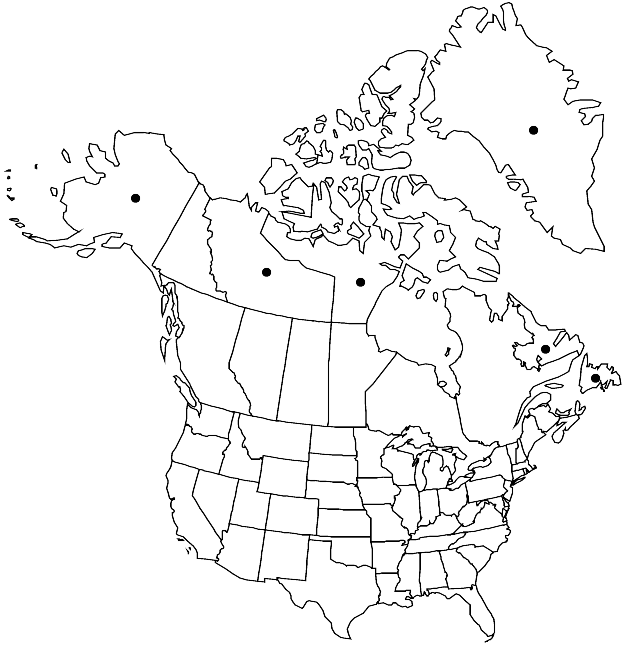Difference between revisions of "Ptychostomum acutiforme"
Phytologia 89: 113. 2007.
FNA>Volume Importer |
imported>Volume Importer |
||
| (6 intermediate revisions by 2 users not shown) | |||
| Line 7: | Line 7: | ||
|year=2007 | |year=2007 | ||
}} | }} | ||
| − | |basionyms={{Treatment/ID/ | + | |basionyms={{Treatment/ID/Basionym |
|name=Bryum acutiforme | |name=Bryum acutiforme | ||
|authority=Limpricht | |authority=Limpricht | ||
| + | |rank=species | ||
| + | |publication_title=Tromsø Mus. Aarsh. | ||
| + | |publication_place=21–22: 156. 1901 | ||
}} | }} | ||
|synonyms= | |synonyms= | ||
| Line 26: | Line 29: | ||
|elevation=low to moderate elevations (0-600 m) | |elevation=low to moderate elevations (0-600 m) | ||
|distribution=Greenland;Nfld. and Labr.;N.W.T.;Nunavut;Alaska;n Eurasia. | |distribution=Greenland;Nfld. and Labr.;N.W.T.;Nunavut;Alaska;n Eurasia. | ||
| − | |discussion=<p>Ptychostomum acutiforme is related to P. calophyllum, but differs in its ovate-lanceolate leaves with acuminate apices. The leaves have red to red-brown costae and proximal laminal cells narrower than the more distal cells. The hypophysis is thick and abruptly contracted to the seta.</p> | + | |discussion=<p><i>Ptychostomum acutiforme</i> is related to <i>P. calophyllum</i>, but differs in its ovate-lanceolate leaves with acuminate apices. The leaves have red to red-brown costae and proximal laminal cells narrower than the more distal cells. The hypophysis is thick and abruptly contracted to the seta.</p> |
|tables= | |tables= | ||
|references= | |references= | ||
| Line 35: | Line 38: | ||
-->{{#Taxon: | -->{{#Taxon: | ||
name=Ptychostomum acutiforme | name=Ptychostomum acutiforme | ||
| − | |||
|authority=(Limpricht) J. R. Spence | |authority=(Limpricht) J. R. Spence | ||
|rank=species | |rank=species | ||
| Line 50: | Line 52: | ||
|publication year=2007 | |publication year=2007 | ||
|special status= | |special status= | ||
| − | |source xml=https:// | + | |source xml=https://bitbucket.org/aafc-mbb/fna-data-curation/src/2e0870ddd59836b60bcf96646a41e87ea5a5943a/coarse_grained_fna_xml/V28/V28_266.xml |
|genus=Ptychostomum | |genus=Ptychostomum | ||
|subgenus=Ptychostomum subg. Ptychostomum | |subgenus=Ptychostomum subg. Ptychostomum | ||
Latest revision as of 21:34, 5 November 2020
Plants in dense or open turfs, green, yellow-green, or brown. Stems 1–2 cm, fertile stems comose, innovations evenly foliate. Leaves yellow-green to yellow-brown, somewhat distant, weakly contorted to somewhat imbricate when dry, ovate-lanceolate, concave or sometimes flat, 0.5–2(–3) mm, enlarged toward stem apex; base red near costa, green otherwise, not decurrent; margins plane, limbidium moderately strong, in (1–)2–3 rows; apex acute to acuminate; costa not reaching apex to percurrent, apiculus sometimes present, short, slender; proximal laminal cells long-rectangular, (3–)4–5:1; medial cells somewhat longer, walls incrassate; distal cells 18–25 µm wide, 2–3:1, walls thin to incrassate. Specialized asexual reproduction absent. Sexual condition autoicous. Seta red-brown, 2–4 cm, stout, straight to somewhat flexuose. Capsule red-brown or red, ovate, symmetric, 2–3 mm, mouth yellow to yellow-orange; operculum conic, apiculate; peristome reduced; exostome teeth yellow basally, hyaline distally, lamellae ± straight mid tooth, pores absent along mid line; endostome not adherent to exostome, basal membrane less than 1/2 exostome height, segments with lanceolate to slitlike perforations, cilia absent or rudimentary. Spores with size often variable in same capsule, 28–32 µm, yellow or brown.
Phenology: Capsules mature Jul–Aug.
Habitat: Moist gravelly to sandy soil, near sea, along streams, around lakes
Elevation: low to moderate elevations (0-600 m)
Distribution

Greenland, Nfld. and Labr., N.W.T., Nunavut, Alaska, n Eurasia.
Discussion
Ptychostomum acutiforme is related to P. calophyllum, but differs in its ovate-lanceolate leaves with acuminate apices. The leaves have red to red-brown costae and proximal laminal cells narrower than the more distal cells. The hypophysis is thick and abruptly contracted to the seta.
Selected References
None.